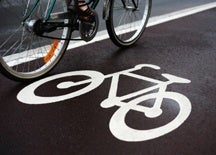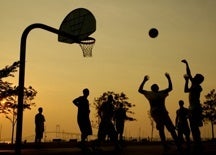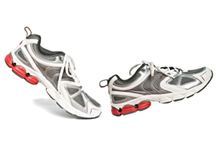Building Places that Get People Moving
Our surroundings can have a profound impact on our actions. This is especially so when it comes to physical activity. If a city has few sidewalks, for example, few people will walk places. If there are no safe places to ride bikes, few people will commute by bike to work or school. If there are no gyms nearby, few people will have a safe and comfortable place to exercise.
- Active Living by Design: Main Website

- Active Living Research: Main Website

- Centers for Disease Control and Prevention: Designing and Building Healthy Places

- City of New York: Active Design Guidelines

- Leadership for Healthy Communities: Active Living

- National Association of City Transportation Officials: Urban Bikeway Design Guide

- National Center for Safe Routes to School: Main Website

- Public Health Law and Policy:Toolkit: Opening School Grounds to the Community After Hours

- University of North Carolina: Bike to Work
 | BicylingInfo.Org
| BicylingInfo.Org  |WalkingInfo.org
|WalkingInfo.org
- World Health Organization: Health Economic Assessment Tool for Walking and Cycling

- Families: Creating active families
- Early Child Care: Healthy activity, screen time, and sleep
- Schools: Staying active throughout the school day
- Worksites: Promoting physical activity at work
- Physical Activity: Exercise can help control weight
- Environmental Barriers to Activity:Where people live and work affects how active they are
In a nation—and, increasingly, world—where people get less and less physical activity, the “built environment”—the actual physical structures that make up the places where we live, eat, work, play, and go to school—is a key component in the fight against obesity. And it deserves a great deal of attention.
An activity-friendly environment is one that offers a variety of safe and affordable ways to be active. Some environmental changes can help people weave activity into their everyday routines, such as promoting active transportation, so people can walk or ride bikes to shops, school, and workplaces; instituting land use practices that discourage pedestrian-unfriendly sprawl; or designing buildings with attractive stairs, bicycle storage rooms, and layouts that encourage people to get up from their desks. These everyday activity approaches hold promise because they don’t require people to add “exercise” to the to-do list. Other changes can promote active “play” for all ages during free time, such as by opening school gyms to community use on evenings and weekends, or improving public safety, so that people feel comfortable being active outdoors. Media campaigns and social marketing can also help change social norms and encourage people to become more active as part of their daily routine and during their free time.
Integral to implementing such strategies are concerted efforts across many disciplines—transportation and city planners, private developers and employers, community groups and educators. Small-scale changes to the built environment can make a difference. Large-scale changes can make a difference. Together over time, they can provide the structure and support needed to make real and robust strides again obesity.
This section of the website summarizes broad recommendations for improving the physical activity environment, based on a review of expert guidance from the Centers for Disease Control and Prevention, the Institute of Medicine, the World Health Organization, and other major governmental, professional, and public health advocacy organizations. While many of the recommendations are aimed at the local level, state and national governments also play an important role. For more detailed guidance on these recommendations and ideas for putting them into practice, explore the source list on each page, as well as the links to useful toolkits and other resources. Keep in mind that these recommendations are based primarily on a review of U.S. expert guidance, unless otherwise indicated; in other countries, different policy approaches may be needed to achieve improvements in the physical activity environment.
Community Design and Active Transportation

Building routine activity into daily life means changing the way that our communities are built. Community designs that discourage urban sprawl, prioritize recreation space, and facilitate safe walking and biking can increase everyday opportunities to be active. So can improvements to public transportation, since in the U.S., nine out of 10 public transit trips involve walking at the start or end of the route. While many of these land use and transportation changes take place at the local level, all levels of government play a role. The key is to connect planning and development to public health.
Here is a summary of community planning, design, and transportation strategies to promote walking, bicycling, and active lifestyles. It’s based on a review of expert guidance from the Institute of Medicine, the U.S. National Physical Activity Plan, and others. For more detailed guidance on these recommendations and ideas for putting them into practice, explore the source list and the links to other resources.

- Association of Public Health Observatories: Health Impact Assessment Gateway

- Centers for Disease Control and Prevention: Designing and Building Healthy Places

- National Association of City Transportation Officials: Urban Bikeway Design Guide—Cycle Tracks

- National Complete Streets Coalition:Main Website

- National Center for Safe Routes to Schools: Main Website

- Robert Wood Johnson Foundation:Health Impact Project

- University of California: Health Impact Assessment Clearinghouse

- University of North Carolina:
Bike to Work | BicylingInfo.Org
| BicylingInfo.Org  |WalkingInfo.org
|WalkingInfo.org
- World Health Organization: Health Economic Assessment Tool for Walking and Cycling

- Safe, Affordable, and Accessible Physical Activity
- Mass Media and Technology to Encourage Physical Activity
Read and print the complete list of healthy activity environment recommendations.
| Make increased physical activity a priority in the planning of new development and transportation projects, such as by incorporating Health Impact Assessments (1,2,3,4) |
| Adopt zoning policies, such as allowing residential and commercial uses near each other (mixed-use development), that promote active transportation to destinations and make it easier to access physical activity and recreation areas (4,5) |
| Create policies that encourage new schools to be sited in locations that allow children to bike and walk to school(2,4,5,6) |
| Incorporate Safe Routes to Schools and Safe Routes to Worksites, such as Bike-to-Work, into transportation planning, to encourage bicycling and walking to school and work (3,4,6) |
Improve the infrastructure for walking and biking, to promote active transportation (3,5,6)
|
| Adopt “traffic calming” street design standards and elements to reduce vehicle speed and promote safe bicycling and walking, for all ages (1,3,6) |
| Improve access to and use of public transportation, such as by offering reduced fares and improved service (5,6) |
Community Design and Active Transportation—Source List
1. National Prevention Council. National Prevention Strategy . Washington, D.C.: U.S. Department of Health and Human Services, Office of the Surgeon General; 2011.
. Washington, D.C.: U.S. Department of Health and Human Services, Office of the Surgeon General; 2011.
2. White House Task Force on Childhood Obesity. Solving the Problem of Childhood Obesity within a Generation. Washington, D.C.: White House Task Force on Childhood Obesity; 2010.
Washington, D.C.: White House Task Force on Childhood Obesity; 2010.
3. National Physical Activity Plan. National Physical Activity Plan for the United States . 2010. Accessed February 2, 2012.
. 2010. Accessed February 2, 2012.
4. Institute of Medicine. Preventing Childhood Obesity: Health in the Balance . Washington, D.C.: The National Academies Press; 2005.
. Washington, D.C.: The National Academies Press; 2005.
5. Keener D, Goodman K, Lowry A, Zaro S, Kettel Khan L. Recommended community strategies and measurements to prevent obesity in the United States: Implementation and measurement guide.Atlanta: U.S. Dept. of Health and Human Services Centers for Disease Control and Prevention; 2009.
6. IOM (Institute of Medicine) and National Research Council. Local Government Actions to Prevent Childhood Obesity . Washington, D.C.: The National Academies Press; 2009.
. Washington, D.C.: The National Academies Press; 2009.
7. The Center for Research and Contract Standardization in Civil Engineering (CROW). CROW-Record 25: Design Manual for Bicycle Traffic. Ede, The Netherlands: CROW; 2006.
Safe, Affordable, and Accessible Physical Activity

Pricey gym memberships, unsafe parks, and other similar barriers can get in the way of turning free time into active time—for children, but also for adults of all ages. The public and private sectors can work together to lower the cost of sports programs or equipment, ensuring more equal access to recreation spaces and places. Crime- and violence-prevention measures can make neighborhoods feel safer, removing a major barrier to being active outdoors.
Here is a summary of broad strategies that communities can use to make recreational physical activity safe, affordable, and accessible. It is based on a review of expert guidance from the Institute of Medicine, the U.S. National Physical Activity Plan, and others. For more detailed guidance on these recommendations and ideas for putting them into practice, explore the source list and the links to other resources.

- Active Living Research: Tools and Resources
 | The Potential of Safe, Secure, Accessible Playgrounds to Increase Children’s Physical Activity
| The Potential of Safe, Secure, Accessible Playgrounds to Increase Children’s Physical Activity
- Leadership for Healthy Communities: Active Living

- National Complete Streets Coalition:Main Website

- National Policy and Legal Analysis Network to Prevent Childhood Obesity: Model Joint Use Agreement Resources

- Prevention Institute: Addressing the Intersection: Preventing Violence and Promoting Healthy Eating and Active Living

- Public Health Law and Policy:Toolkit: Opening School Grounds to the Community After Hours

Read and print the complete list of healthy activity environment recommendations.
| Build, maintain, and increase access to parks, athletic facilities, and recreation areas, especially in low-income communities (1,2,3,4,5,6,7) |
| Increase community access to gyms, ball fields, and other recreation areas at schools, non-profits, and businesses or corporate campuses, through joint-use agreements (3,6,8,9,10,13) |
| Provide low- or no-cost physical activity programs, facilities, or equipment (e.g. bicycles) for children, families, and adults of all ages (6,8,10) |
| Provide economic incentives to promote the development and use of parks, recreation areas, fitness and sports facilities, and physical activity programs(6,8,11) |
| Increase community policing to ensure safe environments for physical activity (8,9,10,12,13) |
Use crime- and violence-prevention measures to create safe environments that encourage physical activity(5,6,8,9,10,12,13)
|
| Use traffic-safety measures, such as expanded sidewalks, protected bike lanes, and traffic-calming street designs, to create safe environments that encourage physical activity (5,6,8,10,12) |
Safe, Affordable, and Accessible Physical Activity—Source List
1. Tester JM. The built environment: designing communities to promote physical activity in children.Pediatrics . 2009;123:1591-8.
. 2009;123:1591-8.
2. Institute of Medicine. Preventing Childhood Obesity: Health in the Balance . Washington, D.C.: The National Academies Press; 2005.
. Washington, D.C.: The National Academies Press; 2005.
3. White House Task Force on Childhood Obesity. Solving the Problem of Childhood Obesity within a Generation . Washington, D.C.: White House Task Force on Childhood Obesity; 2010.
. Washington, D.C.: White House Task Force on Childhood Obesity; 2010.
4. U.S. Department of Health and Human Services. The Surgeon General’s Vision for a Healthy and Fit Nation . Rockville, MD: U.S. Department of Health and Human Services, Office of the Surgeon General; 2010.
. Rockville, MD: U.S. Department of Health and Human Services, Office of the Surgeon General; 2010.
5. Robert Wood Johnson Foundation. Childhood Obesity: Our Strategy . Robert Wood Johnson Foundation, 2011. Accessed February 2, 2012.
. Robert Wood Johnson Foundation, 2011. Accessed February 2, 2012.
6. National Physical Activity Plan. National Physical Activity Plan for the United States . 2010. Accessed February 2, 2012.
. 2010. Accessed February 2, 2012.
7. World Health Organization. Global Recommendations on Physical Activity for Health . Geneva, Switzerland: World Health Organization; 2010.
. Geneva, Switzerland: World Health Organization; 2010.
8. IOM (Institute of Medicine) and National Research Council. Local Government Actions to Prevent Childhood Obesity . Washington, D.C.: The National Academies Press; 2009.
. Washington, D.C.: The National Academies Press; 2009.
9. Health and Human Services. 2008 Physical Activity Guidelines for Americans ; 2008.
; 2008.
10. National Prevention Council. National Prevention Strategy . Washington, D.C.: U.S. Department of Health and Human Services, Office of the Surgeon General; 2011.
. Washington, D.C.: U.S. Department of Health and Human Services, Office of the Surgeon General; 2011.
11. National Coalition for Promoting Physical Activity. NCPPA Public Policy Platform . Accessed February 2, 2012.
. Accessed February 2, 2012.
12. Keener D, Goodman K, Lowry A, Zaro S, Kettel Khan L. Recommended community strategies and measurements to prevent obesity in the United States: Implementation and measurement guide.Atlanta: U.S. Dept. of Health and Human Services Centers for Disease Control and Prevention; 2009.
13. Prevention Institute. 2010. Addressing the Intersection: Preventing Violence and Promoting Healthy Eating and Active Living .
.
Mass Media and Technology to Encourage Activity

Mass media and social media can help motivate people to get off the couch and get moving, through targeted campaigns that influence individual behavior and change social norms around physical activity. Smart phones, social gaming, and other technology may also help make activity more fun—and more likely to become an everyday habit.
Here is a brief summary of recommendations for how mass media and technology can be used to promote physical activity. It’s based on a review of expert guidance from the Institute of Medicine and others. For more detailed guidance on these recommendations and ideas for putting them into practice, explore the source listand the links to other resources.

- Centers for Disease Control and Prevention: Gateway to Health Communication and Social Marketing Practice

- Robert Wood Johnson Foundation:Health Games Research Database

| Develop a federally funded, coordinated mass media and social marketing campaign with consistent messages and branding to promote physical activity (1) |
Develop state and local media campaigns emphasizing the benefits of increasing physical activity (1,2)
|
| Encourage new media, smart phone, and other technology and entertainment companies to develop products that promote physical activity (1,3) |
Mass Media and Technology to Encourage Activity—Source List
1. National Physical Activity Plan. National Physical Activity Plan for the United States . 2010. Accessed February 2, 2012.
. 2010. Accessed February 2, 2012.
2. IOM (Institute of Medicine) and National Research Council. Local Government Actions to Prevent Childhood Obesity . Washington, D.C.: The National Academies Press; 2009.
. Washington, D.C.: The National Academies Press; 2009.
3. White House Task Force on Childhood Obesity. Solving the Problem of Childhood Obesity within a Generation . Washington, D.C.: White House Task Force on Childhood Obesity; 2010.
. Washington, D.C.: White House Task Force on Childhood Obesity; 2010.
Terms of Use
The aim of the Harvard School of Public Health Obesity Prevention Source Web site is to provide timely information about obesity’s global causes, consequences, prevention, and control, for the public, health and public health practitioners, business and community leaders, and policymakers. The contents of this Web site are not intended to offer personal medical advice. You should seek the advice of your physician or other qualified health provider with any questions you may have regarding a medical condition. Never disregard professional medical advice or delay in seeking it because of something you have read on this Web site. The Web site’s obesity prevention policy recommendations are based primarily on a review of U.S. expert guidance, unless otherwise indicated; in other countries, different policy approaches may be needed to achieve improvements in food and physical activity environments, so that healthy choices are easy choices, for all.